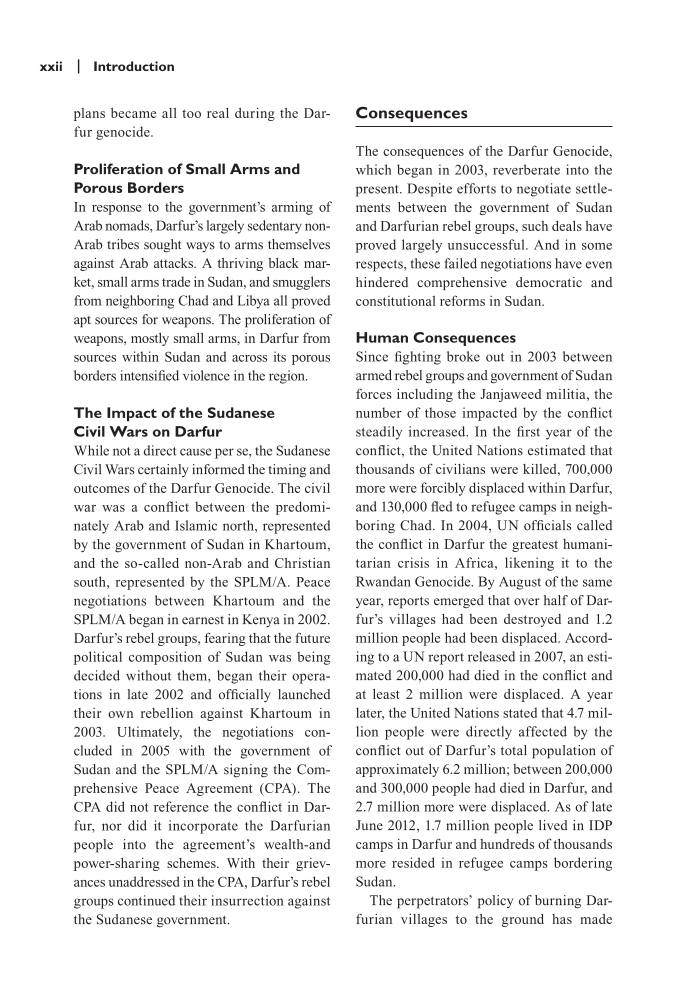xxii | Introduction plans became all too real during the Dar- fur genocide. Proliferation of Small Arms and Porous Borders In response to the government’s arming of Arab nomads, Darfur’s largely sedentary non- Arab tribes sought ways to arms themselves against Arab attacks. A thriving black mar- ket, small arms trade in Sudan, and smugglers from neighboring Chad and Libya all proved apt sources for weapons. The proliferation of weapons, mostly small arms, in Darfur from sources within Sudan and across its porous borders intensified violence in the region. The Impact of the Sudanese Civil Wars on Darfur While not a direct cause per se, the Sudanese Civil Wars certainly informed the timing and outcomes of the Darfur Genocide. The civil war was a conflict between the predomi- nately Arab and Islamic north, represented by the government of Sudan in Khartoum, and the so-called non-Arab and Christian south, represented by the SPLM/A. Peace negotiations between Khartoum and the SPLM/A began in earnest in Kenya in 2002. Darfur’s rebel groups, fearing that the future political composition of Sudan was being decided without them, began their opera- tions in late 2002 and officially launched their own rebellion against Khartoum in 2003. Ultimately, the negotiations con- cluded in 2005 with the government of Sudan and the SPLM/A signing the Com- prehensive Peace Agreement (CPA). The CPA did not reference the conflict in Dar- nor did it incorporate the Darfurian fur, people into the agreement’s wealth-and power-sharing schemes. With their griev- ances unaddressed in the CPA, Darfur’s rebel groups continued their insurrection against the Sudanese government. Consequences The consequences of the Darfur Genocide, which began in 2003, reverberate into the present. Despite efforts to negotiate settle- ments between the government of Sudan and Darfurian rebel groups, such deals have proved largely unsuccessful. And in some respects, these failed negotiations have even hindered comprehensive democratic and constitutional reforms in Sudan. Human Consequences Since fighting broke out in 2003 between armed rebel groups and government of Sudan forces including the Janjaweed militia, the number of those impacted by the conflict steadily increased. In the first year of the conflict, the United Nations estimated that thousands of civilians were killed, 700,000 more were forcibly displaced within Darfur, and 130,000 fled to refugee camps in neigh- boring Chad. In 2004, UN officials called the conflict in Darfur the greatest humani- tarian crisis in Africa, likening it to the Rwandan Genocide. By August of the same year, reports emerged that over half of Dar- fur’s villages had been destroyed and 1.2 million people had been displaced. Accord- ing to a UN report released in 2007, an esti- mated 200,000 had died in the conflict and at least 2 million were displaced. A year later, the United Nations stated that 4.7 mil- lion people were directly affected by the conflict out of Darfur’s total population of approximately 6.2 million between 200,000 and 300,000 people had died in Darfur, and 2.7 million more were displaced. As of late June 2012, 1.7 million people lived in IDP camps in Darfur and hundreds of thousands more resided in refugee camps bordering Sudan. The perpetrators’ policy of burning Dar- furian villages to the ground has made
Document Details My Account Print multiple pages
Print
You have printed 0 times in the last 24 hours.
Your print count will reset on at .
You may print 0 more time(s) before then.
You may print a maximum of 0 pages at a time.











































































































































































































































































































